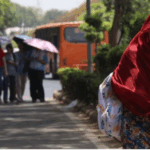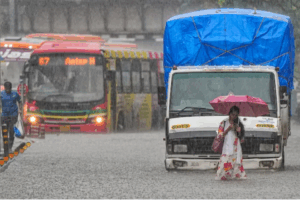THE worst illiterate is the political illiterate, he doesn’t hear, doesn’t speak, nor participates in the political events. He doesn’t know the cost of life, the price of the bean, of the fish, of the flour, of the rent, of the shoes and of the medicine, all depends on political decisions. The political illiterate is so stupid that he is proud and swells his chest saying that he hates politics. The imbecile doesn’t know that, from his political ignorance is born the prostitute, the abandoned child, and the worst thieves of all, the bad politician, corrupted and flunky of the national and multinational companies. — Bertolt Brecht
About the Project: Publicly Available Information
MAHSR (Mumbai-Ahmedabad High Speed Rail) is proposed between Mumbai and Ahmedabad with 12 stations- Mumbai, Thane, Virar, Boisar (Maharashtra), Vapi, Bilimora, Surat, Bharuch, Vadodara, Anand, Ahmedabad and Sabarmati (Gujarat). It has total route length of 508 km and the total project cost is estimated to be Rs. 1.1 lakh crores. The scheduled completion deadline is August 15, 2023. National High-Speed Rail Corporation Limited (NHSRCL) is implementing the project. NHSRCL is a Special Purpose Vehicle (SPV) with equity participation by Ministry of Railways (Central government) and the state governments of Gujarat and Maharashtra. The Ministry of Railways has contributed INR 500 crore as share capital. Government of Gujarat has contributed INR 5 crore.NHSRCL also plans to build an exclusive training institute at Vadodara for personnel training.
A number of feasibility studies of the MAHSR have been done. Based on a set of studies conducted in 2011, a feasibility report was published in 2015 (available on the NHSRCL website). Another titled ‘HSR: Indigenous People Plan’ (also in April 2015) was prepared by TARU Leading Edge, a private consultancy based in Delhi, on behalf of the consortium of funding agencies (JICA, Oriental Consultants Global and Nippon Koei). In 2012, JICA had published a ‘needs survey’ of HSR in India.
However, the detailed project report (DPR) and other essential details such as financial viability study are completely missing. Does this mean that the studies conducted in 2011 and the associated feasibility report are being used as to implement the project?
Let’s Examine What These Documents Say
THE feasibility report of MAHSR is quite detailed but interestingly four key chapters of this report are missing. The missing chapters (12 to 15) contain details on project cost, implementation plan, financing options, and most importantly economic and financial analysis. These chapters could have shed some light on calculation of costs and estimated direct/indirect benefits of the project. Only these chapters could help eliminating citizens’ suspicions related to the burden of debt and financial viability of MAHSR. This curious case of missing chapters hints at bad planning and bad implementation.
The report is based on a joint study conducted by JICA and Ministry of Railways, GoI. It has comprehensive discussion on all the aspects of MAHSR project. What is disappointing is that the aim of the study appears to be to justify the project rather than dispassionate assessment of viability and relevance of this project.
Our Concerns: Transport and Mobility Needs: Transport Planning Perspective
1. Where are the users?
The report claims a daily ridership forecast of 40,000 passengers in the year 2023. This is ridiculously optimistic if one goes by the present day passenger traffic data used by the study itself. Daily air traffic on Mumbai-Ahmedabad route was 4700, as reported by the study. Combined traffic of all the modes between pair of other cities where the stations have been planned is also very small as compared to the forecast. Even though the rationale of planning these stations is to increase the ridership, it is difficult to see how that would help achieve the forecast target.
Traffic forecasts in the study are based on relationship between GDP growth rate and air traffic over the years. This is too simplistic. Growth in domestic air traffic witnessed during past few years has to do as much as with increase in income levels of a certain class as with the remarkable decrease in air fares brought by plummeting prices of jet fuel, technological improvements, and competition within the aviation sector. All available evidence suggests that the current boom in domestic air traffic is likely to keep the fares at much lower levels than the proposed fare of Rs. 3000 for a bullet train ride between Mumbai and Ahmedabad. The feasibility study uses outdated airfare input of 4100 rupees while these days the fare ranges from Rs. 1500-4600 with a month-long average of nearly Rs. 2000. The key question is: to what extent will speed enhancement draw richer income classes away from air travel?
Traffic contributed by other modes of transport is even more difficult to convert. Around 5000 people travel by trains run by Indian railways while another 15,000 people travel by personal automobile between Mumbai and Ahmedabad daily, according to the feasibility study. Usually a Willingness-To-Pay (WTP) survey is conducted to capture people’s travel preferences and needs and how likely is it that they would pay for different kind of service, or an enhancement in the service quality etc. WTP method has drawn strong criticism over the years because of lack of reliability, and other serious limitations. People often do not fully understand how a proposed service would serve them and their response to WTP survey is disconnected with realities. Since people are not well-informed about the choices, their responses are usually invalid. Therefore, payment ceiling (highest price that people are “willing” to pay) values are based on fallacious assumptions.
WTP method can be a tool to fudge demand, if proper accountability mechanisms are not in place. Yet, it continues to be a standard method for feasibility studies and appraisals. In any case, the results of the WTP survey have been reported cursorily in the feasibility report. The story is almost unbelievable: An example of how absurd the data is presented in the chart (from the feasibility report). According to this, as many as 86 out of 100 people who travel by air between Mumbai and Ahmedabad have monthly income of less thanRs. 13000 per month! It is predicted that from each mode of transport 60% of passengers will switch to the bullet train from the first day of operation. This is equally absurd. This is like planning a luxury hotel of 50 floors assuming that its 40 floors will be packed by the poor and the lower-middle class. Surely, the desperation of a seller (Japanese capitalists) and fetish of a buyer (Indian State) is capable of creating such magic!
In short, Willingness-To-Pay survey and the travel demand forecast look completely unreliable. Model predictions of modal shares which have been used to come up with the popular “40000” mark do not correspond to the real world conditions as the data does not make sense. The forecasting method is questionable on technical grounds. Willingness-To-Pay survey seems to be badly designed and badly conducted. All this warrants a fresh, well-designed, and closely supervised survey. Before proceeding any further, these serious gaps must be addressed. Before making a decision on whether to spend public money on a project of this scale, government must order a rigorous enquiry and make the feasibility study data public and open-access.
2. How will the bullet train earn back?
The claim that Indian bullet train will be cheapest in the world is definitely a lie. Turkey and China both have cheaper fares on similar distance ranges. Even the feasibility report admits that fares will be higher than High Speed Rail (HSR) fares in Taiwan, Turkey and China in PPP terms. Taiwan HSR had to be shut down because of low ridership- less than half as predicted ridership. For similar distance range (500 km), a ride on Chinese bullet trains may cost 200-300 Chinese Yuan which translated in PPP terms becomes around 1000-1500 INR. If lower fares have not been able to pull off HSR experiments in developing economies, viability of Indian HSR experiment is quite bleak.
Another weakness of NHSRCL’s claim is the “innovative” fare-box revenue model that they have chosen not to make public (the curious case of missing chapters mentioned earlier). Fare-box revenue is that part of total expenses which is met by the fares paid by the users. Across the globe, transport services do not recover the expenses through farebox alone, apart from some cases of air travel. A study by scholars of IIM-Ahmadabad showed that100 daily trips at full occupancy would be required with a fare of 5000 rupees between Ahmedabad and Mumbai to make the bullet train financially viable. Recovery of capital cost and maintenance cost – both of which are quite large – is not possible only through fare-box. It is not clear how these costs will be recovered to keep the project economically viable.
3. Myth of timesaving and the idea of transport
Value of travel time savings is not a constant. Elasticity of this value may depend on many factors including demographics, income, occupation, cultural context etc. Value of travel time savings is a complex phenomenon. Recent research in transport planning has shown that people do not find the travel time necessarily unproductive. In a study of Chinese HSR train journeys, researchers found that overnight sleeper trains (conventional trains) are preferred to the low-fare trains as well as the costlier high speed trains. It has been argued that HSR will relax the necessity to live in the city and it will allow people to live in distant exurban locations and other cities.Planners of MAHSR think that a high-speed rail network would enable the working class to shift from the dense metropolitan areas (where the jobs are) to places likeBoisar and Nadiad where there is scope for “developing” land for residential purposes. This strikes a chord with the interests of real estate companies but it is unlikely to lure the majority of the working class.Will the working class people value 8 hours of daily travel (and an expensive one) while sitting in a chair (or in a car, or standing in an urban rail) more than living near their work location? Bullet train will not run in the night, so why would people not take a cheaper rail ticket in sleeper classes (AC or non-AC) and complete the journey while not disturbing their sleep.
Over the years, it has been realized that speed is not the only parameter of interest in transport planning. Enhancing people’s accessibility to destinations is equally important. Therefore, appraisal of transport projects must be in terms of increase in access. People do not live at stations and terminals. People have to travel to these nodes. These parts of a journey can be called access (coming to these nodes from starting point of the journey) and egress (from node to the final destination). Access and egress times play a really important role in people’s choice of travel mode. A speedier network connecting two nodes can reduce time spent on that segment while the overall time that people end up spending on travel may not reduce, or worse- it may actually shoot up.
That is why high-speed rail (bullet type) is not competitive against personal automobile or conventional railway for distances less than 150 km1. Average speed of an HSR with stoppage at every 20 miles will be similar to that of a conventional express train, if operated properly. HSR with speed more than 250 kmph is advantageous only in the distance range of 500-1000 km. Bullet train can be the most probable choice among available alternatives only forthe end-to-end trips i.e. between Mumbai and Ahmedabad. For travel between other pairs of MAHSR stations, existing suburban railway and urban/inter-city bus services have enormous scope of improvement with comparably miniscule investment. While evaluating the competitiveness of HSR against conventional railways, this fact must also be taken into consideration. Efforts should be made that trains like Gatimaan Express, the newly inaugurated “semi-high speed” train on Delhi-Jhansi route which is achieving average speed of 90 kmph, are operated on other routes where these are needed.
4. What is inspiring the MAHSR: Recent history of transport ‘mega’-projects
Some commentators have cited example of Rajdhani trains and Delhi Metro as previous experiments which also had raised similar suspicions among a group of scholars and civil society members. There are several problems with this argument.
First, much of the ridership on Rajdhani trains is possibly due to bad condition of superfast and express trains in terms of punctuality and operational regularity, not in terms of travel time. Between a punctual superfast train and a Rajdhani on the same route, it is quite hard to predict if the demand will be higher for the Rajdhani.
Second, Rajdhani trains run on the same track which is used by other trains. Therefore, land, forests and people are not affected in any particular way. HSR route will be an exclusive Right-Of-Way (ROW) which will put the forests in danger, displace people and take away the farm lands and other livelihood options of the affected population.
Third, the comparison of HSR with the Delhi Metro is not quite right because the Metro (an urban mode of transport) provides connectivity between suburban locations and city while HSR is best viewed as medium-distance regional transport. Yet, the same questions are applicable for Delhi Metro. Is it not true that disputable “success” of Delhi Metro has much to do with total neglect of bus transport in Delhi-NCR? Is the Indian government thinking of branding MAHSR as “success” along the lines of Delhi Metro by keeping the wider Indian Railways network in a state of neglect?
It is true, as the Japanese experience suggests, that Shinkansen technology is absolutely safe. These trains have not witnessed any fatal accidents in their history of almost 50 years. Inductive reasoning suggests that Indian HSR (being built with the same technology) should not face any fatal crashes. Nonetheless, it is agreeable that the technology is quite safe. But this leads us to another important question- should the government go for an option which ensures safety of a few, or should the government rather prioritize investment in research and policies with aim to upgrade the safety of conventional rail system which is being used by tens of million people daily?
The question of whether to plan an HSR is central to a more fundamental debate: what should the idea of transportation be. More specifically, how does the HSR correspond to the sustainable regional and urban transport in the Indian context?
Government of India had set up a high level committee named National Transport Development Policy Committee (NTDPC) with the objective of developing a long term national transport policy. In its report submitted in the year 2012, the committee had recommended that priority should be semi-high speed rail (160-200 kmph), not HSR: “Thus, given the substantial funding required from government to implement HSR projects, a programme for raising speed to 160-200 kmph on selected existing routes should be undertaken till the time the HSR projects are found commercially justified or operationally required to cater to the country’s growth and mobility needs.”
Why is the HSR project being taken up despite that it is not aligned with the national transport policy? Why has the NTDPC report failed to find recognition in the decision-making of this government? On what basis does this government disagree with the recommendations of the NTDPC? Has this government or NITI Ayog come up with any other policy document equivalent to or superior than the NTDPC report? If not, shouldn’t a democratically elected govt rethink the bullet train project? The least that a government can do is to be transparent and accountable to its people in all its decisions. Unfortunately, that’s what is missing in case of bullet train project.


















